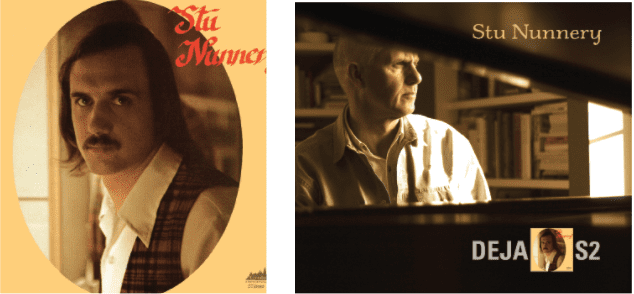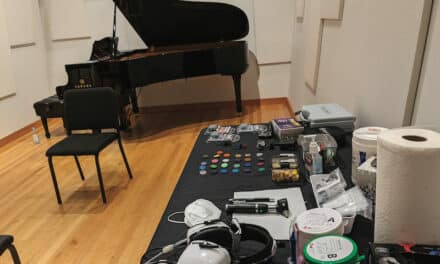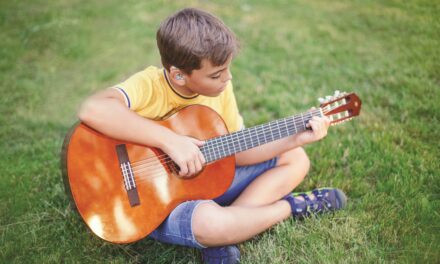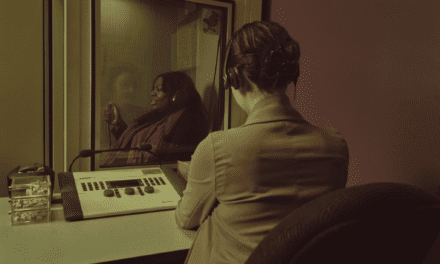Audiology to Extend a Musicians’ Career | October 2018 Hearing Review
A 35-year hiatus from music due to hearing loss, and a new beginning due to dedication
As a professional singer/musician/performer, my efforts to rebuild my musical self after a bilateral hearing loss some 40+ years ago have been especially daunting. It has been one thing to play an instrument again; it has been quite another to play an instrument and sing along. Not only is my sensory focus split, but for many years severe tinnitus on the left side, recurring tinnitus on the right, pitch distortion, and the resulting cacophony, curbed even the desire to further my musical activities.
Nevertheless, I had always hoped for a happy ending to my musical despair—some miracle tech or medical breakthrough, perhaps. If not, then…
How Would I Get There?
1) Passion and resolve. Working in my favor is that I love nothing more than being able to sit at the piano, sing, and perform. For a time, it was also a highly lucrative form of work that ended precipitously. I am willing to do whatever it takes to get back—in whatever ways I can.
2) Motivation. Since 1974, I have enjoyed a large international fan base and decades of attention that I was unable to respond to. In 2014, I was newly rediscovered through my story with hearing loss. I am eager to connect with my fans again.
3) A catalog. I have dozens of songs—some recorded and never released, others waiting to be recorded, and still others newly written. I don’t want them to die on the vine.
With this background, I needed a strategy. Here’s mine:
Keeping Up with Hearing Technology
Things started to turn in 2009 when I received my first digital hearing aid. Today, in my right and functioning ear only, I wear a hearing aid with two music programs that provide a less processed and flatter sound in both unidirectional and omnidirectional settings.
Getting Auditory Training
In 2013, I was referred to Geoff Plant, an auditory trainer near Boston, Mass. His focused listening techniques enhance my speech comprehension, strengthen my musical hearing, and clear up some of the clutter I experience when listening to or making music.
Listening
After decades away from it, I listen to and enjoy music again. I hear music well that I remember from before 1982, but cannot hear precise melody lines for newer music. Nevertheless, over time I noticed with increasing clarity all kinds of music by allowing it to play without judgement and just letting it transport me. I can now hear the pull of a bow on a violin, an entire orchestra or band playing together, and can pick out instruments and individual notes on a piano or classical guitar—even if the exact melody remains vague.
Getting Vocal Coaching
For me, hearing music is as much visceral and emotional as it is an aural and neurologic activity. Vocal coaching has helped get music back into my body. It reminds me that pitch can be felt as well as heard. Proper breathing technique improves my vocal stamina for sustaining a note, and with it, pitch.
Performing Live
In 2015, with new hearing aid technology, auditory training, vocal work, and a wing and a prayer, I got up on a stage for the first time in 35 years at a friendly house concert. It was an unmitigated disaster—but informative. Hitting a C2 to get me lined up vocally, I did not realize that what I “heard” was a half to a full tone sharp. I spent the entire “concert” singing off key. I repeated that mistake a week later. But a musical friend began working with me to help me find the correct hearing aid settings and where on the keyboard I could find my pitch sweet spot: an octave or two above C2. By spring of 2016, I declared myself “safe for listening in a live venue.”
Focusing on Pitch
With my hearing losses, holding pitch will always be my challenge. While it continues to improve, it is always a matter of several things—from the settings I use on my hearing aid, the song that I am singing, the key that I am singing in, the level of my tinnitus at any moment, the acoustics and background noise in a venue, to the temperature and humidity in a recording studio. Each outing presents a different set of challenges which I try to manage in several ways: I rehearse with a singer with very good hearing and pitch. When performing live, I play parts of the melody line I am singing with my right hand to provide a pitch guide for my vocals. In the studio, I lay down a straight melody line on the piano as a guide to sing with.
Recording
As the saying goes, “the tracks don’t lie.” It’s a hard lesson to learn, but you can get away with things live that you cannot in the studio. In 2015, one of my audiologists, Brian Fligor, fitted me with customized ear monitors from Sensaphonics for use in the studio and for live performances. The monitors include an analog hearing aid for my right ear and a CROS for the left ear. I’m also experimenting with wearing my hearing aid during sessions and singing to a click track.
Telling My Audiences the Truth
As I work out the technical aspects, nothing has helped me get over my anxieties better than being straight with my audiences. Today, hearing loss in musicians is out of the closet, so I find audiences much more understanding —intrigued, in fact—and it gives me room to do my thing without being overly self-conscious. I refer to my live performances as “works in progress,” and if something goes awry, “It’s all part of the show, folks.”
Teaching Others
I promote my own and have been hired to run other workshops about music and hearing loss. I am able to inspire others and it has given me the freedom to be wholly transparent about my own challenges. I get to perform in a live venue and then use my own challenges as demo points in my presentations.
A New Beginning
In a perfect case of good timing, I have exciting news to report. In July of this year, I completed two new original recordings that I was unable to complete in 2017. They are my first releases in more than 40 years. A miracle, yes, in many ways. But more importantly, it was 5 years of hard work and discovery along with breakthroughs on the neurological and technical sides. And let me not forget the countless people who stepped into my journey to guide me.

Left: Stu Nunnery’s 1973 self-titled LP. Right: his recent CD which can be purchased at https://store.cdbaby.com/cd/stununnery and on Apple iTunes.
Whatever It Takes
Returning to music after hearing loss? Try these suggestions:
- Don’t let “the perfect” be the enemy of the good. Rebuilding your musical self is complex and hard work—and very rewarding. Be easy on yourself and enjoy the journey, a step at a time.
- Record yourself often and learn from the results.
- Test new technologies and apps as they arrive on the market.
- Check out auditory training for what it can add to your toolbox.
- Listen—just listen—to music in every genre, every day, and be amazed at what you might discover about your hearing.
- Work with a vocal coach and learn what you can about music from the inside out.
- Get out and perform and don’t look back.
- Get comfortable with your truth and use it to teach and inspire others.
About the Author:
Stu Nunnery is a writer, composer, singer, recording artist, and hearing activist. In 1973, Nunnery released a self-titled LP on Evolution Records that bore two songs that reached the Top-100 on the US Pop Charts while another became a #1 record in Brazil. He enjoyed a prolific career, writing and singing national advertising campaigns and composed the parade theme “I’m Walkin’ Right Down the Middle of Main Street USA” which remains one of Disney’s signature musical performance pieces. Between 1978 and 1980, Stu suffered bilateral hearing loss and a partial loss of sight that would end his music career for more than 35 years. In 2013, he began a years-long strategy to resume his music career through technology, auditory training, and vocal coaching.
Citation for this article: Nunnery S. Rebuilding my musical self. Hearing Review. 2018;25(10)[Oct]:24-25.
INDEX TO “Audiology to Extend a Musicians’ Career” special October 2018 edition of The Hearing Review:
Loss Plus Correction Equals Baseline, by Charles Mokotoff
Keeping it Simple, by Larry Revit, MA
Composing with Hearing Loss, by Richard Einhorn
Notes from an Early-Deafened Musician, by Wendy Cheng
How to Use a Bluetooth Streaming Device in Music Performance and Recording at Home, by Rick Ledbetter
OTC: Let’s Get on the Same Page!, by Karl E. Strom







I have profound hearing loss. I am a classically trained musician with a DMA in Music Education from the Eastman School of Music and former music educator. I am 83. I was a conductor of an instrumental ensemble when around 1994 I began to notice I was having trouble hearing performers talk to me or ask questions. In 1995, I decided to have my hearing checked, all the time denying I could have hearing loss, but my tests proved I did indeed have a mild hearing loss. In spite of the results of my testing and initial purchase of two hearing aids I refused to wear them especially when conducting. My rationale was “how could a conductor of a respected ensemble with trained performers wear hearing aids and remain respected?” Finally, after discussing my dilemma with my good friend and advisor at the Eastman School I learned there are quite a few professional musicians who wear hearing aids. After that, I “gave in” and wore them.
Now, I’m at the point where I am considering cochlear implants. Even though my current hearing aids have 5 programs including: normal; restaurant; music; T-coil and TV streaming. I have major problems hearing speech in any kind of noisy environment and because of this I have distanced myself from any form of group activity, becoming more secluded and depressed.
Music has been my life and the “music program” on my H-aids still makes it possible for me to enjoy (with some limitation) symphony orchestra performances. I am still able to usher for our local symphony which is an excellent professional orchestra.
I have attended several cochlear implant sessions offered by the three major suppliers of cochlear implants. The consensus of opinion is getting cochlear implants makes listening to music near to impossible. Since this is an irreversable decision this is a horrible thing to hear. It seems I’m at the point where I have to choose between hearing speech better or hearing music but not speech.
I am searching for information from anyone who has suffered through this state of being and found satisfaction with a particular brand or model of cochlear implant.
I would appreciate hearing from anyone who would be willing to share their experiences with me. Thank you!